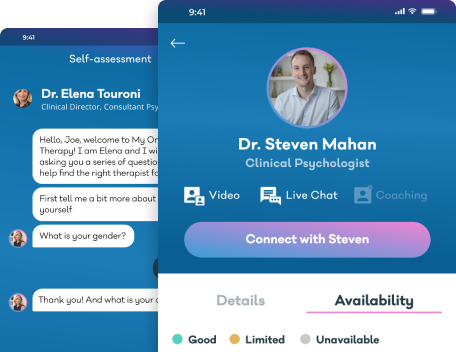We all experience panic from time to time. It’s a natural response to stressful or dangerous situations, and sometimes it protects us from harm.
But a panic attack is when the body triggers a disproportionate flight-or-fight response — even though there’s no real danger or apparent cause.
Panic attacks can be a nerve-wracking experience, especially if you’ve never had one before. Simply put, it’s an abrupt episode of intense fear. It causes adrenaline to rush into the body — and the physical symptoms can be pretty terrifying.
Some people feel as if they’re having a heart attack, others believe they can’t breathe, and some even faint or throw up.
Thankfully though, most people only have one or two panic attacks in their lifetimes and then they subside — perhaps when a stressful situation ends.
But if you’ve had recurrent, unexpected attacks or live in fear of another attack you may have what’s called a panic disorder.
Why do people have panic attacks?
Like a lot of mental health conditions, the exact cause of panic attacks isn’t fully understood. However, there are a few different factors that can increase your risk of having a panic attack.
These include:
- Family history of panic attacks
- Major life stresses, such as the death or illness of a loved one
- Traumatic events, such as sexual assault
- Significant life changes, such as job loss, divorce or the arrival of a baby
- Excessive caffeine intake or smoking
- History of childhood physical or sexual abuse
- Some people may also experience panic attacks when they’re exposed to an object or situation they have a phobia about
What are the symptoms of a panic attack?
Not sure if you experienced a panic attack? Symptoms vary from person to person but here are just a few of the tell-tale signs:
- Racing or pounding heartbeat
- Feeling faint
- Nausea
- Shortness of breath
- Shaky limbs
- Trembling
- Chest pains
- Numbness or pins and needles
- Dry mouth
- Dizziness
- Sweating
What is panic disorder?
If you repeatedly experience unexpected panic attacks and continually worry that another may strike, you might be diagnosed with a panic disorder.
Thankfully though, with the right support and treatment, panic disorders are fairly manageable.
How to overcome panic attacks
The good news is that you don’t have to live your life in fear of panic attacks. Here are a few ways to help you manage your panic attacks — or prevent them from happening in the first place:
Don’t resist it and remind yourself that you’re safe
If you’re in the middle of a panic attack, don’t try to fight or resist it as this may make you feel worse. If possible, try to stay where you are. But if you’re driving, pull over and park where and when it’s safe to do so.
Remind yourself that although panic attacks are scary, they typically last 5 to 20 minutes. So even though you feel terrible, you are safe and nothing bad is going to happen to you. Like all emotions, this surge of panic will eventually pass.
After a panic attack, you might be so frightened that it’ll happen again that you might avoid public places. But this creates a vicious cycle of anticipatory anxiety, which can make day-to-day life difficult.
It can feel like you’re always “living in fear”, which can add to your sense of panic and may cause you to have more attacks. Because of this, it’s best to try and go about your daily routine as usual.
Slow breathing
Have you ever noticed that when you’re in a state of panic, your breathing becomes faster and more irregular?
It happens because our bodies have entered fight-or-flight mode. To be sure that our bodies are ready for action, we breathe quicker to increase our oxygen intake. But if there’s no real threat or danger, it’s a lot less helpful.
It can leave us feeling lightheaded, anxious and out of control. That’s why, if you’re having a panic attack, slowing down your breathing can really help.
Simply make your exhale longer than your inhale, and keep going until you settle into a breathing rate that feels right to you. You might decide to inhale for four seconds and exhale for six seconds, for instance.
Grounding
It’s not uncommon to feel detached from your body or surroundings during a panic attack. It’s called depersonalisation or derealisation.
For that reason, if you think you’re having a panic attack it can be helpful to try some ‘grounding techniques’. These ground you in the present moment and make you more aware of your body and surroundings.
One grounding exercise that can help pull yourself back to reality is the ‘54321 grounding technique’. This is where you name:
- 5 things you can see.
- 4 things you can touch.
- 3 things you can hear.
- 2 things you can smell.
- 1 thing you can taste.
This will stop you from zoning out and allow you to be more present.
Alternatively, you could try listening to your favourite song or a guided meditation. If you don’t know where to start, be sure to check out our new digital tool, Self-care. It’s packed with real-life therapy exercises and techniques to help you feel grounded, relaxed and calm when emotions are running high.
Talk to your loved ones
Reach out to a friend or a loved one. They can squeeze your hand, guide your breathing, and tell you that you’re going to be okay. Sometimes simply talking to someone can keep you grounded in the present moment.
If you let your loved ones know what you’re going through they might even educate themselves on the topic and learn other techniques to help you cope.
Visit a GP
If your panic attacks are becoming more regular, lasting longer or generally impacting your day-to-day life, remember that you don’t have to struggle alone. A good first step is to chat with your GP.
It can be difficult to open up about what we’re going through, but there’s nothing to feel anxious or embarrassed about. Your GP will ask you to describe your symptoms and they may also carry out a physical exam to rule out any other conditions.
You may be diagnosed with a panic disorder if you have regular and unexpected panic attacks, and are continuously worried about further attacks. Your GP will then point you towards treatment, which may include medication and talking therapies.
Practice self-care
Since stress is a common trigger for panic attacks, try to squeeze some self-care into your daily routine. For instance, you could try to destress and unwind by taking a yoga class or trying meditation.
You could try some more rigorous exercise if you want to get a boost of feel-good hormones. Or alternatively, you could schedule a few minutes to do something you enjoy, whether that’s baking, gaming or getting lost in your favourite page-turner.
Lifestyle changes
Avoid caffeine and alcohol and stop smoking, as they can make panic attacks worse.
Try muscle relaxation techniques
Muscle relaxation techniques are a great stress-buster that can help stop panic attacks in their tracks.
By consciously relaxing and tensing each body part it makes us feel calmer and in control. However, muscle relaxation techniques work best when you’ve practised them a few times before.
You simply want to tense and then relax each muscle group, starting with something simple like the fingers in your hand and then move your way throughout your body.
Go to therapy
Cognitive Behaviour Therapy (CBT) is often the first choice of treatment for people with panic disorders.
In your session, a psychologist will teach you different ways to recognise and replace the negative thoughts that come along with having panic attacks. Plus they’ll teach you different coping techniques to help you tackle stress, better manage your anxiety and cope with panic symptoms.
We know just how scary panic attacks can be but remember that they don’t have to take over your life. We can help you tackle those feelings of fear, panic and anxiety head-on so that you can live your life to the fullest.

